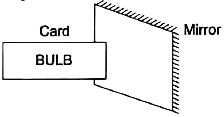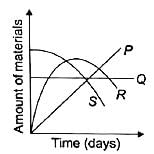All Exams >
Class 6 >
Science Olympiad Class 6 >
All Questions
All questions of Section-3: Achievers Section for Class 6 Exam
Which of the following statement(s) is true for formation of compost from vegetable waste:
i. It is a physical change.
ii. An irreversible change and a slow change
iii. A chemical and non-desirable change.
iv. A chemical and desirable change- a)i and ii
- b)ii and iii
- c)iii and iv
- d)iv only
Correct answer is option 'D'. Can you explain this answer?
Which of the following statement(s) is true for formation of compost from vegetable waste:
i. It is a physical change.
ii. An irreversible change and a slow change
iii. A chemical and non-desirable change.
iv. A chemical and desirable change
i. It is a physical change.
ii. An irreversible change and a slow change
iii. A chemical and non-desirable change.
iv. A chemical and desirable change
a)
i and ii
b)
ii and iii
c)
iii and iv
d)
iv only
|
|
Navya answered |
Because in chemical change substances are formed as here a new substance is formed and this does not harms the environment and is useful too
The amount of precipitation that soaks into the soil depends on- a)how long the rain lasts.
- b)whether or not there are plants around.
- c)whether the soil is wet or dry.
- d)all of the choices
Correct answer is option 'D'. Can you explain this answer?
The amount of precipitation that soaks into the soil depends on
a)
how long the rain lasts.
b)
whether or not there are plants around.
c)
whether the soil is wet or dry.
d)
all of the choices
|
|
Priyanka Sharma answered |
Ans: d
Explanation: The amount of precipitation that soaks into the soil depends on several factors: the amount and intensity of the precipitation, the prior condition of the soil, the slope of the landscape, and the presence of vegetation.
Somya poured hot water into two cups made of same material as shown in the figures below.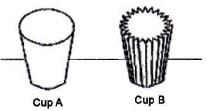 She then realized that she could hold cup B for a longer time as compared to cup A.
She then realized that she could hold cup B for a longer time as compared to cup A.
Q. Which one of the following best explains this activity?- a)Cup A is a better conductor of heat than cup B
- b)Cup B is a better conductor of heat than cup A
- c)Somya’s hand was in contact with a larger surface area for cup B than A
- d)Somya’s hand was in contact with a smaller surface area for cup B than A
Correct answer is option 'D'. Can you explain this answer?
Somya poured hot water into two cups made of same material as shown in the figures below.

She then realized that she could hold cup B for a longer time as compared to cup A.
Q. Which one of the following best explains this activity?
Q. Which one of the following best explains this activity?
a)
Cup A is a better conductor of heat than cup B
b)
Cup B is a better conductor of heat than cup A
c)
Somya’s hand was in contact with a larger surface area for cup B than A
d)
Somya’s hand was in contact with a smaller surface area for cup B than A

|
Roshan kumar Jayaswal. answered |
Somya put the glass in smaller area in the cup B heat is not too and cup A she in larger area then it is too hot
Refer to the given dichotomous key and select the incorrect statement regarding P , Q, R, S and T.
(i) (a) It is a natural fibre. - Go to (ii)
(ii) (b) It is a man-made fibre. - P
(ii) (a) Fibre is obtained from plants.- Go to (iii)
(b) Fibre is obtained from animals.- Go to (iv)
(iii) (a) Fibre obtained from stem. - Q
(b) Fibre obtained from fruit. - R
(iv) Fibre obtained by killing of source organism. - S
(b) Fibre obtained by killing source organism. - T- a)Fibre of P burns quickly and shrinks away from flame giving slightly sweet chemical odour.
- b)Q could be obtained from Corchorus capsularis while R could be obtained from Gossypium hirsutum.
- c)Fibre S is obtained from an insect whereas fibre T is obtained from a mammal.
- d)Fabric made of S can be worn in all seasons whereas fabric made of Q can be used to make a raincoat,
Correct answer is option 'D'. Can you explain this answer?
Refer to the given dichotomous key and select the incorrect statement regarding P , Q, R, S and T.
(i) (a) It is a natural fibre. - Go to (ii)
(ii) (b) It is a man-made fibre. - P
(ii) (a) Fibre is obtained from plants.- Go to (iii)
(b) Fibre is obtained from animals.- Go to (iv)
(iii) (a) Fibre obtained from stem. - Q
(b) Fibre obtained from fruit. - R
(iv) Fibre obtained by killing of source organism. - S
(b) Fibre obtained by killing source organism. - T
(i) (a) It is a natural fibre. - Go to (ii)
(ii) (b) It is a man-made fibre. - P
(ii) (a) Fibre is obtained from plants.- Go to (iii)
(b) Fibre is obtained from animals.- Go to (iv)
(iii) (a) Fibre obtained from stem. - Q
(b) Fibre obtained from fruit. - R
(iv) Fibre obtained by killing of source organism. - S
(b) Fibre obtained by killing source organism. - T
a)
Fibre of P burns quickly and shrinks away from flame giving slightly sweet chemical odour.
b)
Q could be obtained from Corchorus capsularis while R could be obtained from Gossypium hirsutum.
c)
Fibre S is obtained from an insect whereas fibre T is obtained from a mammal.
d)
Fabric made of S can be worn in all seasons whereas fabric made of Q can be used to make a raincoat,

|
Shiksha Academy answered |
According to the given dichotomous key, P is a synthetic fibre like polyester, Q could be jute, flax, etc. R is cotton, S is silk and T is wool.
Paheli moves on a straight road from point A to point C. She takes 20 minutes to cover a certain distance AB and 30 minutes to cover the rest of distance BC. She then turns back and takes 30 minutes to cover the distance CB and 20 minutes to cover the rest of the distance to her starting point. She makes 5 rounds on the road the same way. Paheli concludes that her motion is- a)Only rectilinear motion
- b)Only periodic motion
- c)Rectilinear and periodic both
- d)Neither rectilinear nor periodic
Correct answer is option 'C'. Can you explain this answer?
Paheli moves on a straight road from point A to point C. She takes 20 minutes to cover a certain distance AB and 30 minutes to cover the rest of distance BC. She then turns back and takes 30 minutes to cover the distance CB and 20 minutes to cover the rest of the distance to her starting point. She makes 5 rounds on the road the same way. Paheli concludes that her motion is
a)
Only rectilinear motion
b)
Only periodic motion
c)
Rectilinear and periodic both
d)
Neither rectilinear nor periodic

|
Indu Gupta answered |
Her motion involves moving back and forth along the straight road (rectilinear motion) while also repeatedly covering the same path, indicating a periodic pattern. The combination of both rectilinear and periodic aspects characterizes Paheli's motion in this scenario. Understanding the interplay between these types of motion is fundamental in physics studies.
Read the given statements and select the correct option.
Statement 1 : Rahul placed a coloured plastic bottle in front of the beam of a torch light. Then he placed a transparent sheet of same size on the other side of bottle. No shadow will form on a screen placed behind the sheet.
Statement 2 : Translucent objects allow light to pass through them partially.- a)Both statements 1 and 2 are true and statement 2 is the correct explanation of statement 1.
- b)Both statements 1 and 2 are true but statement 2 is not the correct explanation of statement 1.
- c)Statement 1 is true but statement 2 is false.
- d)Statement 1 is false but statement 2 is true.
Correct answer is option 'D'. Can you explain this answer?
Read the given statements and select the correct option.
Statement 1 : Rahul placed a coloured plastic bottle in front of the beam of a torch light. Then he placed a transparent sheet of same size on the other side of bottle. No shadow will form on a screen placed behind the sheet.
Statement 2 : Translucent objects allow light to pass through them partially.
Statement 1 : Rahul placed a coloured plastic bottle in front of the beam of a torch light. Then he placed a transparent sheet of same size on the other side of bottle. No shadow will form on a screen placed behind the sheet.
Statement 2 : Translucent objects allow light to pass through them partially.
a)
Both statements 1 and 2 are true and statement 2 is the correct explanation of statement 1.
b)
Both statements 1 and 2 are true but statement 2 is not the correct explanation of statement 1.
c)
Statement 1 is true but statement 2 is false.
d)
Statement 1 is false but statement 2 is true.

|
Dr Manju Sen answered |
A colored plastic bottle is an opaque material. When a light beam is incident on it, a shadow will form on the screen. Light can pass through the transparent sheet.
The following picture shows two circuits with batteries and light bulbs.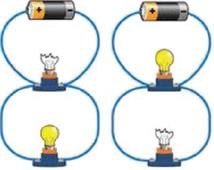 Q. Choose the option which explains the above figure correctly.
Q. Choose the option which explains the above figure correctly.- a)(a) They are the parallel circuits with electricity flowing along one pathway
- b)(b) They are the series circuits with electricity flowing along one pathway
- c)(c) They are the parallel circuits with electricity flowing along more than one pathway
- d)(d) They are the series circuits with electricity flowing along more than one pathway
Correct answer is option 'C'. Can you explain this answer?
The following picture shows two circuits with batteries and light bulbs.

Q. Choose the option which explains the above figure correctly.
a)
(a) They are the parallel circuits with electricity flowing along one pathway
b)
(b) They are the series circuits with electricity flowing along one pathway
c)
(c) They are the parallel circuits with electricity flowing along more than one pathway
d)
(d) They are the series circuits with electricity flowing along more than one pathway

|
Shalini Shalini answered |
Frist one
Refer to the given dichotomous key and select the correct option.I. (a) It is categorised as energy giving food. - Go to II
(b) It is categorised as protective food. - Go to III II. (a) It is soluble in water. - P
(b) It is insoluble in water. - QIII. (a) It is needed for strong bones and teeth. - R
(b) It helps in formation of haemoglobin. - S- a)Q could be glucose which is instant source of energy.
- b)Deficiency of S causes anaemia which is characterised by pale body colour, body fatigue, etc.
- c)Deficiency of R causes beriberi while deficiency of S causes goitre.
- d)P could be butter which gives an oily patch on the filter paper.
Correct answer is option 'B'. Can you explain this answer?
Refer to the given dichotomous key and select the correct option.
I. (a) It is categorised as energy giving food. - Go to II
(b) It is categorised as protective food. - Go to III
(b) It is categorised as protective food. - Go to III
II. (a) It is soluble in water. - P
(b) It is insoluble in water. - Q
(b) It is insoluble in water. - Q
III. (a) It is needed for strong bones and teeth. - R
(b) It helps in formation of haemoglobin. - S
(b) It helps in formation of haemoglobin. - S
a)
Q could be glucose which is instant source of energy.
b)
Deficiency of S causes anaemia which is characterised by pale body colour, body fatigue, etc.
c)
Deficiency of R causes beriberi while deficiency of S causes goitre.
d)
P could be butter which gives an oily patch on the filter paper.
|
|
Subset Academy answered |
According to the given dichotomous key P, Q, R and S could be carbohydrate, fat, calcium and iron respectively.
Refer to the given paragraph.
The two main types of root are X and Y. X roots are mostly found in plants having leaves with reticulate venation, while Y roots are mostly found in plants having leaves with parallel venation.
Select the incorrect statement regarding X and Y.- a)Radish, turnip and carrot are modifications of X.
- b)X is found in gram while Y is found in barley.
- c)X spreads horizontally hence cannot provide strong anchorage whereas Y penetrates very deep into the soil hence provides strong anchorage.
- d)In Y, primary root is short-lived while X has persistent primary root.
Correct answer is option 'C'. Can you explain this answer?
Refer to the given paragraph.
The two main types of root are X and Y. X roots are mostly found in plants having leaves with reticulate venation, while Y roots are mostly found in plants having leaves with parallel venation.
Select the incorrect statement regarding X and Y.
The two main types of root are X and Y. X roots are mostly found in plants having leaves with reticulate venation, while Y roots are mostly found in plants having leaves with parallel venation.
Select the incorrect statement regarding X and Y.
a)
Radish, turnip and carrot are modifications of X.
b)
X is found in gram while Y is found in barley.
c)
X spreads horizontally hence cannot provide strong anchorage whereas Y penetrates very deep into the soil hence provides strong anchorage.
d)
In Y, primary root is short-lived while X has persistent primary root.
|
|
Rutuja Roy answered |
Understanding X and Y Roots
In the context of root types, X and Y represent distinct root systems in plants. Let’s clarify their characteristics to comprehend why option 'C' is incorrect.
Characteristics of X Roots
- X roots, typically associated with plants exhibiting reticulate venation (like dicots), have several key features:
- They often develop a taproot system.
- Modifications of X include radish, turnip, and carrot, which store nutrients.
- X roots, such as those found in gram, provide reliable anchorage due to their deep, primary root structure.
Characteristics of Y Roots
- Y roots, common in plants with parallel venation (like monocots), display different traits:
- These roots form a fibrous system with numerous thin roots.
- They tend to spread horizontally rather than penetrate deeply.
- In Y roots, the primary root is often short-lived, leading to the dominance of secondary roots.
Analysis of Option C
- The statement "X spreads horizontally hence cannot provide strong anchorage whereas Y penetrates very deep into the soil hence provides strong anchorage" is incorrect because:
- X (taproot) provides strong anchorage due to its ability to penetrate deeply into the soil.
- Y (fibrous roots) does spread horizontally, but it does not provide the same level of anchorage compared to deep taproots.
Conclusion
Thus, option 'C' is incorrect because it misrepresents the anchorage capabilities of X and Y roots. X roots actually provide stronger anchorage, while Y roots are characterized by their horizontal spread.
In the context of root types, X and Y represent distinct root systems in plants. Let’s clarify their characteristics to comprehend why option 'C' is incorrect.
Characteristics of X Roots
- X roots, typically associated with plants exhibiting reticulate venation (like dicots), have several key features:
- They often develop a taproot system.
- Modifications of X include radish, turnip, and carrot, which store nutrients.
- X roots, such as those found in gram, provide reliable anchorage due to their deep, primary root structure.
Characteristics of Y Roots
- Y roots, common in plants with parallel venation (like monocots), display different traits:
- These roots form a fibrous system with numerous thin roots.
- They tend to spread horizontally rather than penetrate deeply.
- In Y roots, the primary root is often short-lived, leading to the dominance of secondary roots.
Analysis of Option C
- The statement "X spreads horizontally hence cannot provide strong anchorage whereas Y penetrates very deep into the soil hence provides strong anchorage" is incorrect because:
- X (taproot) provides strong anchorage due to its ability to penetrate deeply into the soil.
- Y (fibrous roots) does spread horizontally, but it does not provide the same level of anchorage compared to deep taproots.
Conclusion
Thus, option 'C' is incorrect because it misrepresents the anchorage capabilities of X and Y roots. X roots actually provide stronger anchorage, while Y roots are characterized by their horizontal spread.
Which is an example of a periodic motion?- a)Oscillation of a pendulum
- b)Motion of a bus on road
- c)Kids sliding down from a slide
- d)A stone dropped from a certain height
Correct answer is option 'A'. Can you explain this answer?
Which is an example of a periodic motion?
a)
Oscillation of a pendulum
b)
Motion of a bus on road
c)
Kids sliding down from a slide
d)
A stone dropped from a certain height

|
Gunjan Lakhani answered |
Periodic motion is characterized by regular and repeated movements around a central position. In this case, the oscillation of a pendulum swinging back and forth is an example of periodic motion. This phenomenon follows a defined pattern and can be studied in relation to pendulum length and period.
Refer to the given dichotomous key.
I. (a) It conducts food, water and mineral to different parts of the plant - Go to II
(b) It acts as primary site of photosynthesis. - Go to III
II. (a) It is modified to protect the plant. - P
(b) It is m odified to store food. - Q
III. (a) It is modified to support the plant. - R
(b) It is modified to trap insects. - S
Select the incorrect option regarding P-S.- a)P could be stem of Bougainvillea whereas S could be leaves of Nepenthes.
- b)Q could be stem of potato whereas R could be tendril of Gloriosa.
- c)Q could be stem of onion whereas S could be leaf of Venus flytrap.
- d)Q could be stem of ginger whereas R could be tendril of grapevine.
Correct answer is option 'D'. Can you explain this answer?
Refer to the given dichotomous key.
I. (a) It conducts food, water and mineral to different parts of the plant - Go to II
(b) It acts as primary site of photosynthesis. - Go to III
II. (a) It is modified to protect the plant. - P
(b) It is m odified to store food. - Q
III. (a) It is modified to support the plant. - R
(b) It is modified to trap insects. - S
Select the incorrect option regarding P-S.
I. (a) It conducts food, water and mineral to different parts of the plant - Go to II
(b) It acts as primary site of photosynthesis. - Go to III
II. (a) It is modified to protect the plant. - P
(b) It is m odified to store food. - Q
III. (a) It is modified to support the plant. - R
(b) It is modified to trap insects. - S
Select the incorrect option regarding P-S.
a)
P could be stem of Bougainvillea whereas S could be leaves of Nepenthes.
b)
Q could be stem of potato whereas R could be tendril of Gloriosa.
c)
Q could be stem of onion whereas S could be leaf of Venus flytrap.
d)
Q could be stem of ginger whereas R could be tendril of grapevine.

|
EduRev Class 6 answered |
According to the given dichotomous key, P and Q are modifications of stem whereas R and S are modifications of leaf. P could be stem thorn for protection of Bougainvillea plant. Q could be modified stem for storing food such as potato and onion. R could be leaf tendril of Gloriosa, which is a modification of leaf for giving support to the plant. S could be leaf of Nepenthes (insectivorous plant), which is modified to trap insects. Grapevine has stem tendrils.
The thin strand of _______________ that we see, are made up of still thinner strand called __________________.- a)Fiber, yarn
- b)Fiber fabrics
- c)Fabrics, fiber
- d)Yarn, fibers
Correct answer is option 'D'. Can you explain this answer?
The thin strand of _______________ that we see, are made up of still thinner strand called __________________.
a)
Fiber, yarn
b)
Fiber fabrics
c)
Fabrics, fiber
d)
Yarn, fibers
|
|
Aaditya Chawla answered |
The thin strand of _______________ that we see, are made up of still thinner strand called __________________.
Answer:
The correct answer is option D: Yarn, fibers.
Explanation:
- Yarn: Yarn is a long, continuous strand of fibers that is used to make fabric, textiles, or knitting and crocheting projects. It is made by spinning or twisting fibers together to form a cohesive thread. Yarn can be made from various materials such as cotton, wool, silk, polyester, etc.
- Fibers: Fibers are the individual strands that are twisted or spun together to form yarn. They are extremely thin and can be natural or synthetic. Natural fibers include cotton, wool, silk, etc., while synthetic fibers are man-made and include materials like polyester, nylon, acrylic, etc.
Example:
Let's take the example of a cotton T-shirt. The thin strand of fabric that we see is made up of a still thinner strand called yarn, which in turn is made up of even thinner individual strands called fibers.
- The cotton fibers are harvested and processed to remove impurities.
- These fibers are then spun or twisted together to form yarn.
- The yarn is then used to weave or knit fabric, which is further processed to create a T-shirt.
In this example, the fabric is made up of yarn, and the yarn is made up of fibers. The fibers are so thin that they are not visible to the naked eye, but when they are spun together to form yarn, they become visible as a thin strand. This yarn is then used to create the fabric we see in everyday items like clothing, curtains, bedsheets, etc.
Therefore, the correct answer is option D: Yarn, fibers.
Answer:
The correct answer is option D: Yarn, fibers.
Explanation:
- Yarn: Yarn is a long, continuous strand of fibers that is used to make fabric, textiles, or knitting and crocheting projects. It is made by spinning or twisting fibers together to form a cohesive thread. Yarn can be made from various materials such as cotton, wool, silk, polyester, etc.
- Fibers: Fibers are the individual strands that are twisted or spun together to form yarn. They are extremely thin and can be natural or synthetic. Natural fibers include cotton, wool, silk, etc., while synthetic fibers are man-made and include materials like polyester, nylon, acrylic, etc.
Example:
Let's take the example of a cotton T-shirt. The thin strand of fabric that we see is made up of a still thinner strand called yarn, which in turn is made up of even thinner individual strands called fibers.
- The cotton fibers are harvested and processed to remove impurities.
- These fibers are then spun or twisted together to form yarn.
- The yarn is then used to weave or knit fabric, which is further processed to create a T-shirt.
In this example, the fabric is made up of yarn, and the yarn is made up of fibers. The fibers are so thin that they are not visible to the naked eye, but when they are spun together to form yarn, they become visible as a thin strand. This yarn is then used to create the fabric we see in everyday items like clothing, curtains, bedsheets, etc.
Therefore, the correct answer is option D: Yarn, fibers.
Arav performed the following experiment.
He pasted a piece of paper onto the inner bottom surface of a glass. He turned the glass upside down and pushed it into a basin of water. He noticed that the paper remained dry. Q. Which property of air does this experiment show? Choose the correct option.
Q. Which property of air does this experiment show? Choose the correct option.- a)Air has mass
- b)Air occupies space
- c)Air cannot dissolve into water
- d)Air takes the volume of the container
Correct answer is option 'B'. Can you explain this answer?
Arav performed the following experiment.
He pasted a piece of paper onto the inner bottom surface of a glass. He turned the glass upside down and pushed it into a basin of water. He noticed that the paper remained dry.
He pasted a piece of paper onto the inner bottom surface of a glass. He turned the glass upside down and pushed it into a basin of water. He noticed that the paper remained dry.

Q. Which property of air does this experiment show? Choose the correct option.
a)
Air has mass
b)
Air occupies space
c)
Air cannot dissolve into water
d)
Air takes the volume of the container

|
Gunjan Lakhani answered |
- The experiment demonstrates that air occupies space.
- When Arav pushed the inverted glass into the water, the air trapped inside prevented water from entering, keeping the paper dry.
- This shows that air takes up space inside the glass, creating a barrier against the water.
- If air did not occupy space, water would fill the glass and wet the paper.
- The experiment effectively illustrates this fundamental property of air.
- When Arav pushed the inverted glass into the water, the air trapped inside prevented water from entering, keeping the paper dry.
- This shows that air takes up space inside the glass, creating a barrier against the water.
- If air did not occupy space, water would fill the glass and wet the paper.
- The experiment effectively illustrates this fundamental property of air.
An example of rectilinear motion is
- a)Apple falling from a tree
- b)Both (a) and (d)
- c)A spinning top
- d)Motion of a car on a straight road
Correct answer is option 'B'. Can you explain this answer?
An example of rectilinear motion is
a)
Apple falling from a tree
b)
Both (a) and (d)
c)
A spinning top
d)
Motion of a car on a straight road
|
|
Ashwini Chauhan answered |
Rectilinear motion example
Rectilinear motion refers to the motion of an object along a straight line. This means that the object moves in a single dimension without any deviation or change in direction.
Example
The correct answer to the question is option 'b', which states that an apple falling from a tree and the motion of a car on a straight road are both examples of rectilinear motion. Let's examine these examples in detail:
1. Apple falling from a tree: When an apple falls from a tree, it follows a straight path towards the ground due to the force of gravity. As long as there are no external factors such as wind or air resistance, the apple will maintain a rectilinear motion until it reaches the ground.
2. Motion of a car on a straight road: When a car travels on a straight road without making any turns or changing directions, it exhibits rectilinear motion. The car moves in a single dimension along the road without any lateral or sideways movement.
Explanation
Rectilinear motion is characterized by the absence of any change in direction. Objects in rectilinear motion move in a straight line, either horizontally, vertically, or at an angle. In the case of the apple falling from a tree, the force of gravity acts vertically downwards, causing the apple to accelerate towards the ground in a straight line.
Similarly, when a car travels on a straight road, the engine's power propels it forward in a straight line. The car's wheels are aligned parallel to the direction of motion, ensuring that it moves without deviating from the intended path.
Conclusion
In summary, rectilinear motion refers to the motion of an object along a straight line without any change in direction. Examples of rectilinear motion include an apple falling from a tree and the motion of a car on a straight road. These examples demonstrate how objects can move in a single dimension without any lateral or sideways movement.
Rectilinear motion refers to the motion of an object along a straight line. This means that the object moves in a single dimension without any deviation or change in direction.
Example
The correct answer to the question is option 'b', which states that an apple falling from a tree and the motion of a car on a straight road are both examples of rectilinear motion. Let's examine these examples in detail:
1. Apple falling from a tree: When an apple falls from a tree, it follows a straight path towards the ground due to the force of gravity. As long as there are no external factors such as wind or air resistance, the apple will maintain a rectilinear motion until it reaches the ground.
2. Motion of a car on a straight road: When a car travels on a straight road without making any turns or changing directions, it exhibits rectilinear motion. The car moves in a single dimension along the road without any lateral or sideways movement.
Explanation
Rectilinear motion is characterized by the absence of any change in direction. Objects in rectilinear motion move in a straight line, either horizontally, vertically, or at an angle. In the case of the apple falling from a tree, the force of gravity acts vertically downwards, causing the apple to accelerate towards the ground in a straight line.
Similarly, when a car travels on a straight road, the engine's power propels it forward in a straight line. The car's wheels are aligned parallel to the direction of motion, ensuring that it moves without deviating from the intended path.
Conclusion
In summary, rectilinear motion refers to the motion of an object along a straight line without any change in direction. Examples of rectilinear motion include an apple falling from a tree and the motion of a car on a straight road. These examples demonstrate how objects can move in a single dimension without any lateral or sideways movement.
Read the following paragraph and answer the questions that follow.
Shobhit performed the following activities at home.
He soaked green gram (moong) seeds in water overnight in a bowl. Next morning, he drained out the excess water and kept the wet seeds in the folds of a muslin cloth. (We should keep the cloth moist all the time by sprinkling the water at regular intervals [once or twice every day]).After another 24 hours, he checked them again. He saw that the seeds began to sprout.
Q. Choose the correct option and answer the following questions.
I. Which part of the plant is used in the previous activity?
II. What makes the nutrient contents increase in the seeds?
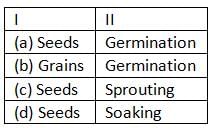
- a)a
- b)b
- c)c
- d)d
Correct answer is option 'A'. Can you explain this answer?
Read the following paragraph and answer the questions that follow.
Shobhit performed the following activities at home.
He soaked green gram (moong) seeds in water overnight in a bowl. Next morning, he drained out the excess water and kept the wet seeds in the folds of a muslin cloth. (We should keep the cloth moist all the time by sprinkling the water at regular intervals [once or twice every day]).After another 24 hours, he checked them again. He saw that the seeds began to sprout.
He soaked green gram (moong) seeds in water overnight in a bowl. Next morning, he drained out the excess water and kept the wet seeds in the folds of a muslin cloth. (We should keep the cloth moist all the time by sprinkling the water at regular intervals [once or twice every day]).After another 24 hours, he checked them again. He saw that the seeds began to sprout.
Q. Choose the correct option and answer the following questions.
I. Which part of the plant is used in the previous activity?
II. What makes the nutrient contents increase in the seeds?
I. Which part of the plant is used in the previous activity?
II. What makes the nutrient contents increase in the seeds?

a)
a
b)
b
c)
c
d)
d

|
Dr Manju Sen answered |
Correct answer is A. Seeds and Germination. The activity describes the soaking and sprouting of seeds, and the increase in nutrient content is due to the process of germination. Therefore, the correct answer is A.
Which is a correct relationship?- a)1 m = 100 cm
- b)1 cm = 100 cm
- c)1 km = 100 m
- d)1 km = 1000 cm
Correct answer is option 'A'. Can you explain this answer?
Which is a correct relationship?
a)
1 m = 100 cm
b)
1 cm = 100 cm
c)
1 km = 100 m
d)
1 km = 1000 cm
|
|
Nilotpal Nambiar answered |
Relationship between meters (m) and centimeters (cm)
Conversion factors are used to convert one unit of measurement to another. In this case, we want to convert between meters (m) and centimeters (cm). The correct relationship is given by the option 'A': 1 meter is equal to 100 centimeters.
1. Understanding the Relationship:
The relationship between meters and centimeters can be understood as follows:
- 1 meter is made up of 100 centimeters.
- This means that if we take a meter and divide it into smaller units, each smaller unit will be 1/100th of a meter, which is equal to 1 centimeter.
2. Conversion Factors:
In the metric system, conversion factors are used to convert between units. A conversion factor is a numerical ratio that relates one unit to another. In this case, the conversion factor between meters and centimeters is 100:1.
3. Using the Conversion Factor:
To convert meters to centimeters, we can use the conversion factor as follows:
- Multiply the given value in meters by the conversion factor of 100.
- The result will be the equivalent value in centimeters.
Example:
Let's say we have a length of 2 meters. To convert it to centimeters, we can use the conversion factor:
2 meters * 100 = 200 centimeters
4. Using the Relationship:
The correct relationship between meters and centimeters is that 1 meter is equal to 100 centimeters. This means that for any given length in meters, we can multiply it by 100 to find the equivalent length in centimeters.
Summary:
- The correct relationship is option 'A': 1 meter = 100 centimeters.
- This relationship is based on the fact that 1 meter is made up of 100 centimeters.
- Conversion factors are used to convert between meters and centimeters, with the conversion factor being 100:1.
- To convert meters to centimeters, multiply the given value in meters by 100.
- The relationship between meters and centimeters allows for easy conversion between the two units of measurement.
Conversion factors are used to convert one unit of measurement to another. In this case, we want to convert between meters (m) and centimeters (cm). The correct relationship is given by the option 'A': 1 meter is equal to 100 centimeters.
1. Understanding the Relationship:
The relationship between meters and centimeters can be understood as follows:
- 1 meter is made up of 100 centimeters.
- This means that if we take a meter and divide it into smaller units, each smaller unit will be 1/100th of a meter, which is equal to 1 centimeter.
2. Conversion Factors:
In the metric system, conversion factors are used to convert between units. A conversion factor is a numerical ratio that relates one unit to another. In this case, the conversion factor between meters and centimeters is 100:1.
3. Using the Conversion Factor:
To convert meters to centimeters, we can use the conversion factor as follows:
- Multiply the given value in meters by the conversion factor of 100.
- The result will be the equivalent value in centimeters.
Example:
Let's say we have a length of 2 meters. To convert it to centimeters, we can use the conversion factor:
2 meters * 100 = 200 centimeters
4. Using the Relationship:
The correct relationship between meters and centimeters is that 1 meter is equal to 100 centimeters. This means that for any given length in meters, we can multiply it by 100 to find the equivalent length in centimeters.
Summary:
- The correct relationship is option 'A': 1 meter = 100 centimeters.
- This relationship is based on the fact that 1 meter is made up of 100 centimeters.
- Conversion factors are used to convert between meters and centimeters, with the conversion factor being 100:1.
- To convert meters to centimeters, multiply the given value in meters by 100.
- The relationship between meters and centimeters allows for easy conversion between the two units of measurement.
Take small amount of food sample in a test tube. Put a few drops of iodine on it. Note down the change in colour. Bluish black colour indicates the presence of (a). The food product (b) can be used for this experiment.Q. Choose the correct option from ‘a’ and ‘b’ and answer the question.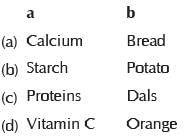
- a)a
- b)b
- c)c
- d)d
Correct answer is option 'B'. Can you explain this answer?
Take small amount of food sample in a test tube. Put a few drops of iodine on it. Note down the change in colour. Bluish black colour indicates the presence of (a). The food product (b) can be used for this experiment.
Q. Choose the correct option from ‘a’ and ‘b’ and answer the question.

a)
a
b)
b
c)
c
d)
d
|
|
Subset Academy answered |
When iodine solution is added to a food sample, it reacts with starch to give a bluish-black color. This is a common test to check for the presence of starch in food. In this case, potato is a food rich in starch. Therefore, the correct food product that can be used for this experiment is potato (option b).
The other options are not correct for this iodine test:
- Calcium is not detected with iodine.
- Proteins are not tested with iodine, but with other methods like biuret reagent.
- Vitamin C does not react with iodine in the same way as starch does.
Swati, Sanchit, Surbhi and Sakshi were talking about the difference between the weaving and knitting.
Q. Who among them correctly made the difference between weaving and knitting?
- a)Swati: The process of making a yarn from fibers is called knitting. And weaving is interlacing of two sets of yarns at right angles to make a fabric
- b)Sanchit: The process of making a yarn from fibers is called weaving. And knitting is interlacing of two sets of yarns at right angles to make a fabric. Weaving is done on looms
- c)Surbhi: Weaving is interlacing of two sets of yarns at right angles to make a fabric. In the knitting process, the thread or yarn is used to create a cloth
- d)Sakshi: Weaving is done for silk only while knitting is done for wool only
Correct answer is option 'C'. Can you explain this answer?
Swati, Sanchit, Surbhi and Sakshi were talking about the difference between the weaving and knitting.
Q. Who among them correctly made the difference between weaving and knitting?
a)
Swati: The process of making a yarn from fibers is called knitting. And weaving is interlacing of two sets of yarns at right angles to make a fabric
b)
Sanchit: The process of making a yarn from fibers is called weaving. And knitting is interlacing of two sets of yarns at right angles to make a fabric. Weaving is done on looms
c)
Surbhi: Weaving is interlacing of two sets of yarns at right angles to make a fabric. In the knitting process, the thread or yarn is used to create a cloth
d)
Sakshi: Weaving is done for silk only while knitting is done for wool only

|
Rahul Kumar answered |
- Weaving:
- Weaving involves interlacing two sets of yarns at right angles to create a fabric. The two sets of yarns are known as the warp (the set that runs lengthwise) and the weft (the set that runs crosswise). This process is typically carried out on a loom.
- Knitting:
- Knitting is a process in which a single thread or yarn is used to create loops, and these loops are interlinked to form a fabric. Knitting can be done by hand or using a knitting machine.
Analyzing the Statements:
- Swati:
- Incorrectly defines knitting as making yarn from fibers (which is actually spinning) and incorrectly defines weaving as interlacing yarns (which is correct but does not relate to knitting).
- Sanchit:
- Incorrectly defines weaving as making yarn from fibers and incorrectly defines knitting as interlacing yarns at right angles (which is actually weaving).
- Surbhi:
- Correctly defines weaving as interlacing two sets of yarns at right angles to make a fabric and correctly states that in knitting, a thread or yarn is used to create a cloth.
- Sakshi:
- Incorrectly claims that weaving is done only for silk and knitting only for wool, which is not true.
John prepares an electric circuit. Study the circuit and find out the correct option.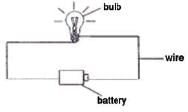 Q. In the circuit given above, electricity passes through the___________
Q. In the circuit given above, electricity passes through the___________- a)Wire only
- b)Battery and bulb only
- c)Wire, battery and bulb
- d)Wire and bulb only
Correct answer is option 'C'. Can you explain this answer?
John prepares an electric circuit. Study the circuit and find out the correct option.

Q. In the circuit given above, electricity passes through the___________
a)
Wire only
b)
Battery and bulb only
c)
Wire, battery and bulb
d)
Wire and bulb only

|
Krishna's Activity answered |
As the electric current passes through positive and negative so the current passes through the wire then the bulb and again the wire and then joins to the negative terminal.
Observe the given figure carefully and select the correct statement.
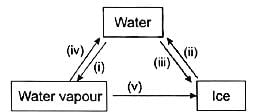
- a)Processes (iii) and (iv) involve absorption of heat energy.
- b)Process (ii) involves absorption of heat energy.
- c)Processes (i) and (iii) evolve heat energy.
- d)Process (v) absorbs a lot of heat energy.
Correct answer is option 'B'. Can you explain this answer?
Observe the given figure carefully and select the correct statement.


a)
Processes (iii) and (iv) involve absorption of heat energy.
b)
Process (ii) involves absorption of heat energy.
c)
Processes (i) and (iii) evolve heat energy.
d)
Process (v) absorbs a lot of heat energy.

|
Praveen Kumar answered |
Processes (i) and (ii) involve absorption of heat energy while processes (iii), (iv) and (v) involve evolution of heat energy.
Four light bulbs P, Q, R and S are concealed from an observer by an opaque wall as shown in the figure. Without shifting the positions of the observer and the bulbs, how many bulbs can the observer see in the mirror?
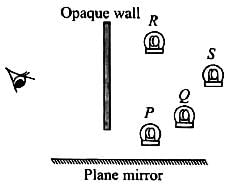
- a)One
- b)Two
- c)Three
- d)All four.
Correct answer is option 'C'. Can you explain this answer?
Four light bulbs P, Q, R and S are concealed from an observer by an opaque wall as shown in the figure. Without shifting the positions of the observer and the bulbs, how many bulbs can the observer see in the mirror?


a)
One
b)
Two
c)
Three
d)
All four.

|
Dr Manju Sen answered |
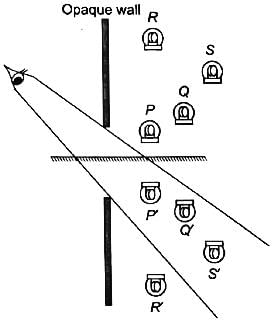
Refer to the given Venn diagram and select the correct statement regarding X, Y and Z.
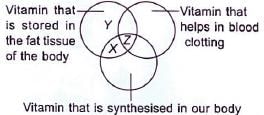
- a)Deficiency of X and Y causes night blindness and scurvy respectively.
- b)X helps in building strong bones and teeth while Y helps in keeping eyes and skin healthy.
- c)Deficiency of Z causes pellagra.
- d)V is a group of several vitamins which forms vitamin complex.
Correct answer is option 'B'. Can you explain this answer?
Refer to the given Venn diagram and select the correct statement regarding X, Y and Z.


a)
Deficiency of X and Y causes night blindness and scurvy respectively.
b)
X helps in building strong bones and teeth while Y helps in keeping eyes and skin healthy.
c)
Deficiency of Z causes pellagra.
d)
V is a group of several vitamins which forms vitamin complex.

|
Dr Manju Sen answered |
In the given Venn diagram X, V and Z represent vitamin D, vitamin E or vitamin A and vitamin K respectively. Deficiency of vitamin A causes night blindness and deficiency of vitamin C causes scurvy. Pellagra is caused by the deficiency of vitamin B3. Vitamin B is a group of eight vitamins (i.e., B1 B2 B3 B5, B6, B7, B9 and B12 and is therefore known as vitamin B-complex.
Refer to the given Venn diagram and select the incorrect statement regarding P, Q and R.
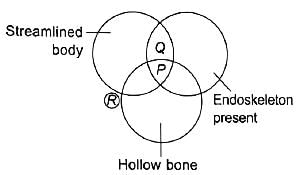
- a)R is a shelled animal that possesses a muscular structure called foot which produces a series of wave like movements, pushing its body forward.
- b)Q has paired and unpaired fins that help in movement in water.
- c)P has special air sacs connected to the lungs which aid in respiration process.
- d)Q has three pairs of jointed legs which help it to walk, run and climb.
Correct answer is option 'D'. Can you explain this answer?
Refer to the given Venn diagram and select the incorrect statement regarding P, Q and R.


a)
R is a shelled animal that possesses a muscular structure called foot which produces a series of wave like movements, pushing its body forward.
b)
Q has paired and unpaired fins that help in movement in water.
c)
P has special air sacs connected to the lungs which aid in respiration process.
d)
Q has three pairs of jointed legs which help it to walk, run and climb.

|
Praveen Kumar answered |
According to the given Venn diagram, P, Q and R could be bird, fish and insect respectively.
Four bulbs P, Q, R and S are connected in a circuit as shown in the given figure. If bulb P fuses, then which of the other bulb(s) will remain lit?

- a)R only
- b)R and S only
- c)Q, R and S only
- d)S only
Correct answer is option 'B'. Can you explain this answer?
Four bulbs P, Q, R and S are connected in a circuit as shown in the given figure. If bulb P fuses, then which of the other bulb(s) will remain lit?


a)
R only
b)
R and S only
c)
Q, R and S only
d)
S only

|
Rainbow Rise Classes answered |
If bulb P fuses, the circuit of bulb Q breaks while the circuit of bulbs R and S remain same as before. Hence Q will not lit while R and S will remain lit.
Study the given flow chart and identify the processes P, Q, R and S carried out in the given sequence for separation of the mixture.
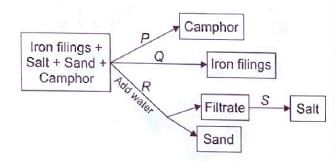
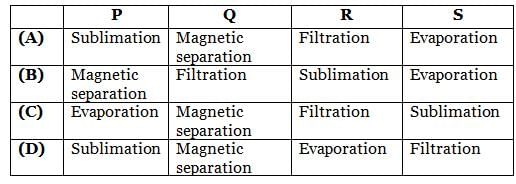
- a)A
- b)B
- c)C
- d)D
Correct answer is option 'A'. Can you explain this answer?
Study the given flow chart and identify the processes P, Q, R and S carried out in the given sequence for separation of the mixture.




a)
A
b)
B
c)
C
d)
D
|
|
Subset Academy answered |
Camphor being sublim able in nature, is separated by sublimation.
Iron filings being magnetic in nature, are separated by magnetic separation method. Sand particles being larger in size and insoluble in water, are separated by filtration. They are obtained in the filter paper, j On evaporating the filtrate, salt is separated.
Iron filings being magnetic in nature, are separated by magnetic separation method. Sand particles being larger in size and insoluble in water, are separated by filtration. They are obtained in the filter paper, j On evaporating the filtrate, salt is separated.
The act of determining size, capacity, or quantity of an object is called- a)Units
- b)Measurement
- c)Pace
- d)Motion
Correct answer is option 'B'. Can you explain this answer?
The act of determining size, capacity, or quantity of an object is called
a)
Units
b)
Measurement
c)
Pace
d)
Motion

|
Shiksha Academy answered |
Measurement refers to the process of quantifying attributes such as size, capacity, or quantity of an object. It involves using standardized units to express these attributes accurately. Understanding measurement is essential in various fields, including science, engineering, and everyday life.
In the given diagram, two switches S1 and S2 and two bulbs X and Y are connected as shown in the given figure. If switch S1 is closed and switch S2 is kept open, then
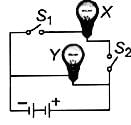
- a)Only bulb X will glow
- b)Only bulb Y will glow
- c)Both bulbs X and Y will glow
- d)Neither bulb X nor bulb Y will alow.
Correct answer is option 'B'. Can you explain this answer?
In the given diagram, two switches S1 and S2 and two bulbs X and Y are connected as shown in the given figure. If switch S1 is closed and switch S2 is kept open, then


a)
Only bulb X will glow
b)
Only bulb Y will glow
c)
Both bulbs X and Y will glow
d)
Neither bulb X nor bulb Y will alow.

|
Praveen Kumar answered |
Since switch S2 is open and S1 is closed, the current will pass through bulb Y. But the circuit is incomplete and there is no complete path for current to flow for bulb X. Hence, only bulb Y will alow.
Geeta placed three objects I, II and II as shown in the figure. She observed a bright spot of light at (II) but (III) would not get any spot. Then,

- a)(I) and (II) are made of transparent materials and (III) is made of opaque material.
- b)(I) is made of transparent material, (II) is made of translucent material and (III) is made of opaque material.
- c)(I) is made of transparent material, (II) is made of opaque material and (III) can be made of either transparent or opaque or translucent material.
- d)(I) and (II) are made of opaque material and (III) is made of transparent material.
Correct answer is option 'C'. Can you explain this answer?
Geeta placed three objects I, II and II as shown in the figure. She observed a bright spot of light at (II) but (III) would not get any spot. Then,


a)
(I) and (II) are made of transparent materials and (III) is made of opaque material.
b)
(I) is made of transparent material, (II) is made of translucent material and (III) is made of opaque material.
c)
(I) is made of transparent material, (II) is made of opaque material and (III) can be made of either transparent or opaque or translucent material.
d)
(I) and (II) are made of opaque material and (III) is made of transparent material.

|
Shiksha Academy answered |
Transparent material allows light to pass through it and opaque object obstructs it.
Swati classified a few changes occurring around us as shown in the table.
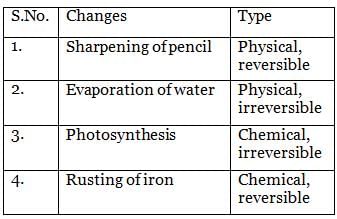 Which of the changes is/are classified correctly?
Which of the changes is/are classified correctly?- a)2 and 3 only
- b)3 and 4 only
- c)1 and 4 only
- d)3 only
Correct answer is option 'D'. Can you explain this answer?
Swati classified a few changes occurring around us as shown in the table.


Which of the changes is/are classified correctly?
a)
2 and 3 only
b)
3 and 4 only
c)
1 and 4 only
d)
3 only

|
Coachify answered |
Sharpening of pencil - Physical, irreversible change
Evaporation of water - Physical, reversible change
Photosynthesis - Chemical, irreversible change
Rusting of iron - Chemical, irreversible change
Evaporation of water - Physical, reversible change
Photosynthesis - Chemical, irreversible change
Rusting of iron - Chemical, irreversible change
Study the given flow chart that shows some ways of garbage disposal and answer the following question.

Which is the best way to dispose the types
of garbage listed below?
a. Vegetable peels
b. Metal pans and pots
c. Hospital wastes
d. Animal droppings
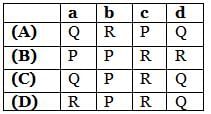
- a)A
- b)B
- c)C
- d)D
Correct answer is option 'C'. Can you explain this answer?
Study the given flow chart that shows some ways of garbage disposal and answer the following question.

Which is the best way to dispose the types
of garbage listed below?
a. Vegetable peels
b. Metal pans and pots
c. Hospital wastes
d. Animal droppings


Which is the best way to dispose the types
of garbage listed below?
a. Vegetable peels
b. Metal pans and pots
c. Hospital wastes
d. Animal droppings

a)
A
b)
B
c)
C
d)
D

|
Vp Classes answered |
Vegetables peels and animal droppings can be disposed by composting. Metal pans and pots can be recycled whereas hospital waste can be disposed by incineration.
Study the given Venn diagram and identify the gases (L, M and N) present in our atmosphere.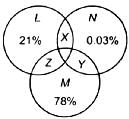 Select the incorrect option regarding characteristics X, Y and Z of these gases
Select the incorrect option regarding characteristics X, Y and Z of these gases- a)X - Support life on Earth
- b)Y - Do not support combustion
- c)Z - Form compounds that are components of acid rain
- d)None of these
Correct answer is option 'D'. Can you explain this answer?
Study the given Venn diagram and identify the gases (L, M and N) present in our atmosphere.

Select the incorrect option regarding characteristics X, Y and Z of these gases
a)
X - Support life on Earth
b)
Y - Do not support combustion
c)
Z - Form compounds that are components of acid rain
d)
None of these

|
Rohini Seth answered |
L, M and N are oxygen (21 %), nitrogen (78%), and carbon dioxide (0.03%), respectively. Oxygen and carbon dioxide gases support life on Earth (X). Oxygen is required by all living organisms for breathing. CO2 is used by green plants for manufacturing food that is directly or indirectly used by different animals to stay alive. CO2 is also a greenhouse gas that prevents heat from escaping Earth’s surface and keeps the temperature of Earth hospitable.
Both nitrogen and carbon dioxide gases do not support combustion (Y). Oxides of nitrogen react with water vapour present in air to form nitric acid which fall down with rain on Earth’s surface as acid rain (Z).
Both nitrogen and carbon dioxide gases do not support combustion (Y). Oxides of nitrogen react with water vapour present in air to form nitric acid which fall down with rain on Earth’s surface as acid rain (Z).
Properties of three solid substances X, Y and Z are given below :
X : Heavy and non-magnetic
Y : Light and non-magnetic
Z : Magnetic
If X, Y and Z are of same size and colour then, which of the following can be used to separate these particles from their mixture?- a)Handpicking followed by filtration
- b)Magnetic separation followed by winnowing
- c)Magnetic separation followed by sieving
- d)Sublimation followed by distillation
Correct answer is option 'B'. Can you explain this answer?
Properties of three solid substances X, Y and Z are given below :
X : Heavy and non-magnetic
Y : Light and non-magnetic
Z : Magnetic
If X, Y and Z are of same size and colour then, which of the following can be used to separate these particles from their mixture?
X : Heavy and non-magnetic
Y : Light and non-magnetic
Z : Magnetic
If X, Y and Z are of same size and colour then, which of the following can be used to separate these particles from their mixture?
a)
Handpicking followed by filtration
b)
Magnetic separation followed by winnowing
c)
Magnetic separation followed by sieving
d)
Sublimation followed by distillation

|
Rohini Seth answered |
First, magnetic particles (Z) are | separated from the mixture by magnetic separation and then heavier particles (X) and lighter particles (Y) are separated by ! winnowing.
Refer to the given flow chart and select the incorrect statement regarding P, Q, R and S.
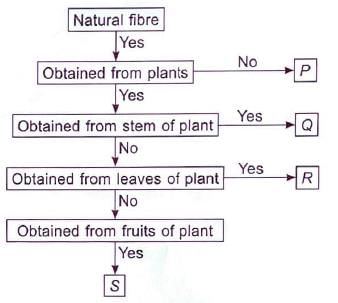
- a)P could be protein fibre whereas Q, R and S could be cellulosic fibres.
- b)Retting is involved in processing of Q whereas ginning is involved in processing of S.
- c)P could be wool, Q could be jute, R could be sisal and S could be cotton.
- d)Fabrics made from P and S are excellent winter clothing whereas fabrics made from Q and R form excellent summer clothing.
Correct answer is option 'D'. Can you explain this answer?
Refer to the given flow chart and select the incorrect statement regarding P, Q, R and S.


a)
P could be protein fibre whereas Q, R and S could be cellulosic fibres.
b)
Retting is involved in processing of Q whereas ginning is involved in processing of S.
c)
P could be wool, Q could be jute, R could be sisal and S could be cotton.
d)
Fabrics made from P and S are excellent winter clothing whereas fabrics made from Q and R form excellent summer clothing.

|
Indu Gupta answered |
In the given flow chart, P could be animal fibre like wool or silk. Q could be jute, flax or hemp. R could be sisal and S could be cotton. Wool is used in winter clothing while cotton is used for summer clothing. Plant stem fibres like jute, flax, hemp are generally used for making bags, ropes, carpets, etc. Sisal which is a leaf fibre is also used for almost same Dumoses.
The table below shows the properties of four substances K, L, M and N.
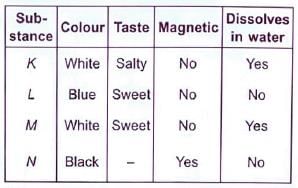
Which two substances would be most difficult to separate when mixed together in water?- a)K and L
- b)K and M
- c)L and N
- d)M and N
Correct answer is option 'B'. Can you explain this answer?
The table below shows the properties of four substances K, L, M and N.

Which two substances would be most difficult to separate when mixed together in water?

Which two substances would be most difficult to separate when mixed together in water?
a)
K and L
b)
K and M
c)
L and N
d)
M and N

|
Rohini Seth answered |
Separation of K and M would be most difficult because both the substances are soluble in water, non-magnetic and have same colour.
One of the four identical light bulbs in a series circuit has blown off as shown in the given figure.
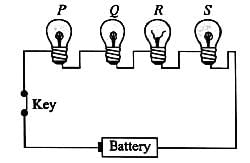 Which of the given statements is correct about the bulbs?
Which of the given statements is correct about the bulbs?- a)R will not glow while P, Q and S will glow as before.
- b)R will not glow while P, Q and S will glow brighter than before.
- c)R will glow brighter than before while P, Q and S will glow as before
- d)All the bulbs P, Q, R and S will not glow.
Correct answer is option 'D'. Can you explain this answer?
One of the four identical light bulbs in a series circuit has blown off as shown in the given figure.


Which of the given statements is correct about the bulbs?
a)
R will not glow while P, Q and S will glow as before.
b)
R will not glow while P, Q and S will glow brighter than before.
c)
R will glow brighter than before while P, Q and S will glow as before
d)
All the bulbs P, Q, R and S will not glow.

|
Coachify answered |
All as the bulbs are in series and bulb R is fused, so the circuit will not be complete and all the bulbs P, Q, R and S will not glow.
Three identical bulbs namely P, Q and R are connected to a battery as shown. What will happen when the circuit is closed?
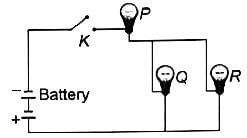
- a)R will glow brighter but Q and P will be dimmer.
- b)P, Q and R all will glow equally bright.
- c)Q and R will immediately burnout.
- d)P will glow brighter, but Q and R will be dimmer.
Correct answer is option 'D'. Can you explain this answer?
Three identical bulbs namely P, Q and R are connected to a battery as shown. What will happen when the circuit is closed?


a)
R will glow brighter but Q and P will be dimmer.
b)
P, Q and R all will glow equally bright.
c)
Q and R will immediately burnout.
d)
P will glow brighter, but Q and R will be dimmer.
|
|
Eduskill Classes answered |
When the circuit is closed, an electric current starts flowing in the circuit from the positive terminal of battery. The current which passes through bulb P is the sum of current flowing in bulbs Q and R. As the brightness depends upon the current flowing through the bulb, so P will be bright but Q and R will be dim.
The properties of four different materials 1,2, 3 and 4 are listed in the given wheel. Fill in the blanks with an appropriate option.
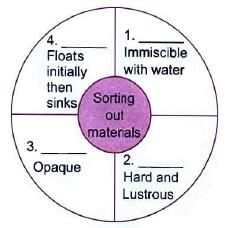

- a)A
- b)B
- c)C
- d)D
Correct answer is option 'C'. Can you explain this answer?
The properties of four different materials 1,2, 3 and 4 are listed in the given wheel. Fill in the blanks with an appropriate option.




a)
A
b)
B
c)
C
d)
D

|
Rohini Seth answered |
Vaseline is immiscible in water as it does not mix completely with water. Metal spoon is hard and lustrous. Cardboard is opaque as it does not allow the passage of light through it. Cotton ball first floats and then sinks when placed in water. This is because once it floats, it starts absorbing water, thus, it becomes heavy and will ultimately sink.
Refer to the given flow chart.
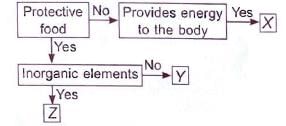
Identify X, Yand Z and select the incorrect statement regarding them.- a)X is formed in leaves of plants during photosynthesis.
- b)Z is essential for the normal functioning of thyroid gland.
- c)Consumption of excess of Y can cause marasmus.
- d) Z helps in formation of haemoglobin in the body.
Correct answer is option 'C'. Can you explain this answer?
Refer to the given flow chart.

Identify X, Yand Z and select the incorrect statement regarding them.

Identify X, Yand Z and select the incorrect statement regarding them.
a)
X is formed in leaves of plants during photosynthesis.
b)
Z is essential for the normal functioning of thyroid gland.
c)
Consumption of excess of Y can cause marasmus.
d)
Z helps in formation of haemoglobin in the body.
|
|
Subset Academy answered |
In the given flow chart, X, Y and Z refer to carbohydrate or fat, vitamin and mineral, respectively.
Look at the Venn diagram. Which of the following objects described here are most likely to be I, II and III? Choose the correct option.
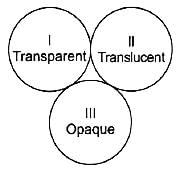

- a)A
- b)B
- c)C
- d)D
Correct answer is option 'B'. Can you explain this answer?
Look at the Venn diagram. Which of the following objects described here are most likely to be I, II and III? Choose the correct option.




a)
A
b)
B
c)
C
d)
D

|
Gunjan Lakhani answered |
Glass is transparent, frosted glass is translucent and wood is opaque.
Look the following compass carefully
Now, observe the following arrangements of magnet and compass and find out which of the following shows the direction of compass when they are put near a bar magnet?

- a)

- b)

- c)

- d)

Correct answer is option 'A'. Can you explain this answer?
Look the following compass carefully
Now, observe the following arrangements of magnet and compass and find out which of the following shows the direction of compass when they are put near a bar magnet?
Now, observe the following arrangements of magnet and compass and find out which of the following shows the direction of compass when they are put near a bar magnet?

a)

b)

c)

d)


|
Gayatri Chavan answered |
- A compass needle aligns itself with the magnetic field lines.
- A bar magnet has a magnetic field with lines that emerge from the north pole and enter the south pole.
- When a compass is near a bar magnet, its north-seeking pole (usually marked) points towards the south pole of the magnet.
- A bar magnet has a magnetic field with lines that emerge from the north pole and enter the south pole.
- When a compass is near a bar magnet, its north-seeking pole (usually marked) points towards the south pole of the magnet.
Given diagram shows the lateral section of a torch containing cells. The torch is not glowing when the switch is ON. Which of the following statements may be correct regarding the reasons?

(i) Bulb of the torch is fused.
(ii) Cells are not connected properly.
(iii) The metal parts of the torch do not make proper contact with the cell.- a)Only (i) and (ii)
- b)Only (ii) and (iii)
- c)Only (i) and (iii)
- d)All (i), (ii) and (iii)
Correct answer is option 'D'. Can you explain this answer?
Given diagram shows the lateral section of a torch containing cells. The torch is not glowing when the switch is ON. Which of the following statements may be correct regarding the reasons?

(i) Bulb of the torch is fused.
(ii) Cells are not connected properly.
(iii) The metal parts of the torch do not make proper contact with the cell.

(i) Bulb of the torch is fused.
(ii) Cells are not connected properly.
(iii) The metal parts of the torch do not make proper contact with the cell.
a)
Only (i) and (ii)
b)
Only (ii) and (iii)
c)
Only (i) and (iii)
d)
All (i), (ii) and (iii)

|
Rainbow Rise Classes answered |
The torch is not glowing because either its bulb is fused or cells are connected wrongly or metal spring of torch does not make proper contact with the cell.
Refer to the given figures, X and Y and select the correct statement regarding them.
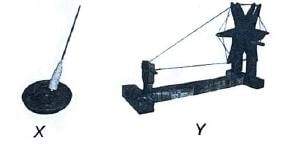
- a)X is used in spinning while Y is used in weaving.
- b)Both X and Y are used in the process of twisting fibres to make yam.
- c)X is used in weaving while Y is used in knitting.
- d)Both X and Y are used in the process of making fabric from two sets of yarns.
Correct answer is option 'B'. Can you explain this answer?
Refer to the given figures, X and Y and select the correct statement regarding them.


a)
X is used in spinning while Y is used in weaving.
b)
Both X and Y are used in the process of twisting fibres to make yam.
c)
X is used in weaving while Y is used in knitting.
d)
Both X and Y are used in the process of making fabric from two sets of yarns.

|
Indu Gupta answered |
Figures X and Y represent takli and charkha respectively. Both takli and charkha are used for spinning i.e., process of twisting fibres to make yam.
Refer to the given figures of machines P, Q, Pand S which represent different joints of our body. Identify the joints according to movement of these machines and select the correct statement.
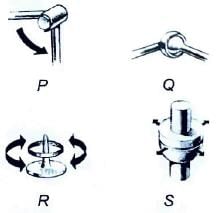
- a)P type of joint is found between the upper arm bone (humerus) and shoulder.
- b)Q type of joint is present in our elbow and knee and allows movement in only one plane.
- c)S type of joint allows side to side as well as backward and forward movement, e.g., wrist joint.
- d)R type of joint allows the highest freedom of motion e.g., hip joint.
Correct answer is option 'C'. Can you explain this answer?
Refer to the given figures of machines P, Q, Pand S which represent different joints of our body. Identify the joints according to movement of these machines and select the correct statement.


a)
P type of joint is found between the upper arm bone (humerus) and shoulder.
b)
Q type of joint is present in our elbow and knee and allows movement in only one plane.
c)
S type of joint allows side to side as well as backward and forward movement, e.g., wrist joint.
d)
R type of joint allows the highest freedom of motion e.g., hip joint.

|
EduRev Class 6 answered |
The given figures P, Q, R and S represent hinge joint, ball and socket joint, pivot joint and gliding joint respectively. Hinge joint (P) is present in our elbow and knee and allows movement in only one plane. Ball and socket joint (Q) allows highest freedom ol motion, e.g., shoulder joint (between humerus and shoulder) and hip joint (between femur and hip bone). Pivot joint (R) also called rotatory joint allows rotatory movement around a single axis. The moving bone rotates within the ring formed from second bone. Joints between firsl and second cervical vertebrae exemplify pivot joint.
Read the given flow chart carefully and fill in the blanks by choosing an appropriate option.
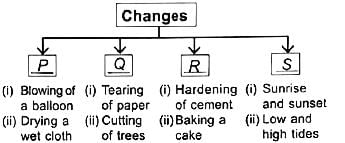
Identify P, Q, R and S.
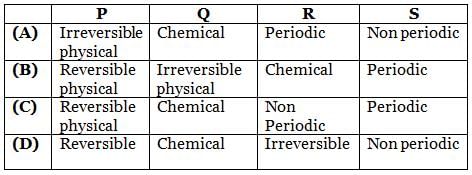
- a)A
- b)B
- c)C
- d)D
Correct answer is option 'B'. Can you explain this answer?
Read the given flow chart carefully and fill in the blanks by choosing an appropriate option.

Identify P, Q, R and S.


Identify P, Q, R and S.

a)
A
b)
B
c)
C
d)
D

|
Rainbow Rise Classes answered |
:Blowing of a balloon and drying of wet clothes are examples of physical, reversible changes as both these changes do not involve any change in the composition and can be reversed. Tearing of paper and cutting of tree are physical changes that cannot be reversed. Hardening of cement and baking of a cake involve chemical reactions, and are thus chemical changes. Sunrise-sunset and low-high tides are examples of periodic changes as these changes occur at regular intervals.
Study the given Venn diagram.
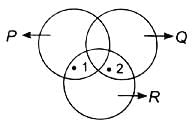
If 1 represents slaking of lime and 2 represents decomposition of calcium carbonate then P, Q and R could be respectively.- a)Reversible change, irreversible change and physical change
- b)Periodic change, non-periodic change and physical change
- c)Exothermic change, endothermic change and chemical change
- d)Endothermic change, exothermic change and chemical change.
Correct answer is option 'C'. Can you explain this answer?
Study the given Venn diagram.

If 1 represents slaking of lime and 2 represents decomposition of calcium carbonate then P, Q and R could be respectively.

If 1 represents slaking of lime and 2 represents decomposition of calcium carbonate then P, Q and R could be respectively.
a)
Reversible change, irreversible change and physical change
b)
Periodic change, non-periodic change and physical change
c)
Exothermic change, endothermic change and chemical change
d)
Endothermic change, exothermic change and chemical change.

|
Vp Classes answered |
Decomposition of calcium carbonate is an endothermic, chemical change as calcium carbonate breaks into calcium oxide and carbon dioxide by absorption of heat. Slaking of lime releases a lot of heat hence, it is an exothermic, chemical change.
Therefore, P should be ‘exothermic’, Q should be 'endothermic' and R should be chemical change.
Therefore, P should be ‘exothermic’, Q should be 'endothermic' and R should be chemical change.
Refer to the given figure representing different layers of Earth’s atmosphere and select the incorrect statement regarding it.
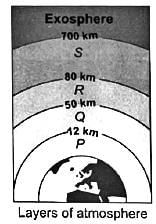
- a)Wind, storm and snow are formed in P layer of atmosphere.
- b)Q is the atmospheric layer where most clouds are formed as, 99% o the water vapours are present in this layer.
- c)In atmospheric layer R meteors burn up.
- d)In atmospheric layer S temperature increases with height.
Correct answer is option 'B'. Can you explain this answer?
Refer to the given figure representing different layers of Earth’s atmosphere and select the incorrect statement regarding it.


a)
Wind, storm and snow are formed in P layer of atmosphere.
b)
Q is the atmospheric layer where most clouds are formed as, 99% o the water vapours are present in this layer.
c)
In atmospheric layer R meteors burn up.
d)
In atmospheric layer S temperature increases with height.
|
|
Subset Academy answered |
In the given figure, labelled parts P, Q, R and S refer to troposphere, stratosphere, mesosphere and thermosphere, respectively. Water vapour and dust constitute clouds in troposphere layer.
Chapter doubts & questions for Section-3: Achievers Section - Science Olympiad Class 6 2025 is part of Class 6 exam preparation. The chapters have been prepared according to the Class 6 exam syllabus. The Chapter doubts & questions, notes, tests & MCQs are made for Class 6 2025 Exam. Find important definitions, questions, notes, meanings, examples, exercises, MCQs and online tests here.
Chapter doubts & questions of Section-3: Achievers Section - Science Olympiad Class 6 in English & Hindi are available as part of Class 6 exam.
Download more important topics, notes, lectures and mock test series for Class 6 Exam by signing up for free.
Science Olympiad Class 6
70 videos|150 docs|104 tests
|

Contact Support
Our team is online on weekdays between 10 AM - 7 PM
Typical reply within 3 hours
|
Free Exam Preparation
at your Fingertips!
Access Free Study Material - Test Series, Structured Courses, Free Videos & Study Notes and Prepare for Your Exam With Ease

 Join the 10M+ students on EduRev
Join the 10M+ students on EduRev
|

|
Create your account for free
OR
Forgot Password
OR
Signup on EduRev and stay on top of your study goals
10M+ students crushing their study goals daily

